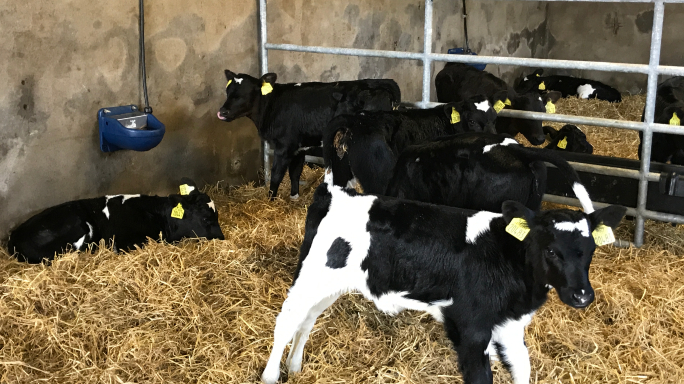Calf health: Pneumonia in youngstock

Calf pneumonia is a multifactorial respiratory disease caused by a range of infectious organisms including viruses and bacteria. Environmental factors and calf husbandry practices also play crucial roles in managing the disease.
Treatment costs, mortalities, reduced growth rates, additional labour and housing requirements all contribute to the significant financial impact of calf pneumonia on farm. Respiratory diseases are considered only second to calf scour as the main cause of death and ill -thrift in calves.
The condition is farm related, with some farms suffering serious losses due to calf pneumonia, while on others the disease is either very mild or non-existent. Sporadic outbreaks can, however, be experienced by farms that normally see very little respiratory disease in calves.
Calf pneumonia is mainly seen across two broad categories of calves:
- Housed dairy replacement calves
- Housed home-bred or bought-in beef calves
However, pneumonia can affect cattle of all ages and Bovine Respiratory Disease (BRD) is most often linked with commingling of cattle from different origins such as marts and feedlots and its occurrence and management is based on the same factors as calf pneumonia.
Dairy calves are likely to suffer from the disease at any age, either as a chronic, coughing pneumonia, or as a more acute form of pneumonia. Apart from a dry cough and slightly increased respiratory rate, very few clinical signs can be present with the chronic form. Characterized by fever, dullness, low appetite, coughing and a runny nose, acute calf pneumonia is often seen as an outbreak affecting several calves within a 2-day window. Older dairy calves are also vulnerable after housing in the autumn. Suckler calves are more likely to suffer from respiratory disease following weaning or transport from one herd to another, this way, outdoor reared beef suckler calves can also be severely affected by pneumonia. Where respiratory disease occurs after transport or other environmental stress, it is often referred to as “shipping fever”.
Environmental and Calf Husbandry Risk Factors for Pneumonia
The main environmental risk factor is poor ventilation in calf housing. Inadequate ventilation of calf housing increases the risk of disease due to the buildup of humidity, noxious gases, dust and bacteria. Cold, humid conditions, sudden changes in air temperature, stress due to different causes and change in the environment can all lead to outbreaks of pneumonia in young calves.
Inadequate intake of colostrum or poor quality colostrum will make calves more susceptible to infection. Apply the 1-2-3 rule for colostrum for best results:
- 1st milk the cow produces after calving
- within 2 hours of birth
- at least 3 litres
Rearing systems where calves of different origin are mixed together at a young age suffer from high levels of respiratory diseases. Large, shared air spaces, calves from different age groups and poor cleaning standards between calf batches often make these systems even more vulnerable.
The stress associated with calf husbandry procedures such as weaning, disbudding and castration can lead to high respiratory disease levels.
Viruses and Bacteria Causing Calf Pneumonia
A variety of viruses and bacteria are involved in different combinations on different farms. Often the viruses are the primary infections and the bacteria cause a secondary infection in an animal whose defenses have already been weakened by the viral infection.
- The most common pneumonia viruses in Irish calves: RSV, PI3 & IBR
- The most common pneumonia bacteria in Irish calves: Mannheimia, Pasteurella, Mycoplasma & Histophilus
Control and Prevention of Calf Pneumonia
The best approach is to have a farm specific control plan in place, drawn up in conjunction with your veterinarian. This plan should cover three areas:
- Maintenance of disease resistance:
- Good quality colostrum will boost the calf’s immune system and make it more resistant to infection during the first 2-3 months of life.
- Vaccines are widely used to boost the calf’s immunity. Vaccines are available for RSV, PI3, IBR, BVDV and Mannheimia, often in combination. The vaccines should be used as part of a disease prevention programme that also addresses the environmental and management factors on the farm. The efficacy of the vaccines can vary between farms.
- Reduction of stress
- In order to reduce stress, disbudding or dehorning and castration could be timed so they don’t coincide with weaning or autumn housing.
- Minimisation of transport, avoidance of marts and eliminating cold stress by shielding calves from draughts and providing deep and dry straw bedding have all been recommended as ways to reduce stress in young calves.
- Overcrowding, poor ventilation and high humidity all cause respiratory stress in calves and make them more susceptible to pneumonia.
- Minimising exposure of infection
- Close contact with other animals allows viruses and bacteria to spread easily. Keeping age groups separate and group sizes small has been shown to reduce respiratory disease.
- Temporary individual housing of dairy calves either indoors or in outside hutches is generally linked to improved calf health. There is benefit to dairy calf health with outdoor housing in hutches especially for the prevention of diarrhoea and pneumonia.
- Keep recently purchased stock separate from the main herd for 2-3 weeks to ensure that they are not carrying a respiratory disease unknowingly.
Treating Calf Pneumonia
The veterinarian will need to identify the cause, management and environmental factors in order to target preventive measures in the future. For the current episode of pneumonia, nursing and isolation of affected calves is important. Your veterinarian will guide you on the course of action and the choice of treatments. In all cases, antibiotics should only be used under veterinary guidance and as outlined in the farms’ herd health plan. Chronic calf pneumonia is often not treated unless the calf has a severe cough. Antibiotics can still be effective, but the calf’s lungs may be damaged beyond repair, despite a long treatment course. Chronic pneumonia in calves is a herd health problem. Improvement of the management and environment and a comprehensive disease control plan is required.
For more information, consult the Glanbia Dairy Calf Management Guidelines booklet.
First Published 3 November 2020.
Tagged with: Dairy
